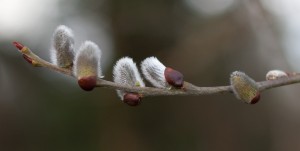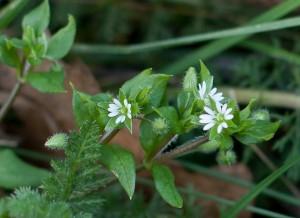I think that most people must have noticed that Spring is not too far away now. It is light in a morning when I walk to work, and, what used to be a fairly quiet walk punctuated by the occasional song thrush or robin singing, is now a cacophony. The great tits are everywhere, but, even more noticeable than these repetitive calls are the songs of the male chaffinches sitting high in the trees.
I thought about going to one of the woods in Northamptonshire that are showing off their carpets of snowdrops, but decided against getting in the car and stayed local instead.
 The trees are starting to show signs of life; hints of green, fat buds and pussy willow starting to look furry. Later on as the air warms these furry grey buds will be a riot of yellow as the male flowers open, providing much needed pollen for insects emerging from hibernation. The bark of this willow (goat willow salix caprea) contains salicin, which is closely related to the active ingredients in aspirin.
The trees are starting to show signs of life; hints of green, fat buds and pussy willow starting to look furry. Later on as the air warms these furry grey buds will be a riot of yellow as the male flowers open, providing much needed pollen for insects emerging from hibernation. The bark of this willow (goat willow salix caprea) contains salicin, which is closely related to the active ingredients in aspirin.
At the country park I found that there were a lot of clumps of snowdrops, but they were only just starting to open and come into flower, and, other than the witch hazel planted near the entrance, most of the colour was provided by the ivy growing up many of the trees. In my endeavours to try and take some pictures of the witch hazel and snowdrops I think I did annoy a pair of great tits that were checking out the nest box nearby.
 The verges around Daventry are littered with crocus, but it is not just the non-natives that are flowering. I found my first celandine of the year, flowering all alone in the grass on the way to the country park, as well as the occasional daisy and one very early dandelion. I also came across some chickweed (pictured) and speedwell flowering. I know that these are weeds and are found pretty much everywhere, but I was surprised to see so many things flowering just a couple of weeks into February. However, I shouldn’t have been surprised. A quick search of the internet resulted in the discovery that common chickweed has been known to flower under snow and that they can self pollinate – hence they are found everywhere, all year round and are considered a weed. How can you fail to be impressed by such a hardy little flower? They are also edible and contain lots of vitamins and minerals as well as supposedly having numerous medicinal properties. But the most endearing feature I found when researching this plant is that at night the leaves fold over tender buds and new shoots. (Information pointing out chickweed’s good points was taken from Alternative Nature Online Herbal, Garden Organic wasn’t such a big fan.)
The verges around Daventry are littered with crocus, but it is not just the non-natives that are flowering. I found my first celandine of the year, flowering all alone in the grass on the way to the country park, as well as the occasional daisy and one very early dandelion. I also came across some chickweed (pictured) and speedwell flowering. I know that these are weeds and are found pretty much everywhere, but I was surprised to see so many things flowering just a couple of weeks into February. However, I shouldn’t have been surprised. A quick search of the internet resulted in the discovery that common chickweed has been known to flower under snow and that they can self pollinate – hence they are found everywhere, all year round and are considered a weed. How can you fail to be impressed by such a hardy little flower? They are also edible and contain lots of vitamins and minerals as well as supposedly having numerous medicinal properties. But the most endearing feature I found when researching this plant is that at night the leaves fold over tender buds and new shoots. (Information pointing out chickweed’s good points was taken from Alternative Nature Online Herbal, Garden Organic wasn’t such a big fan.)